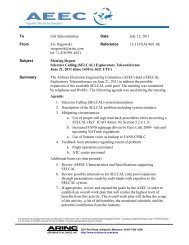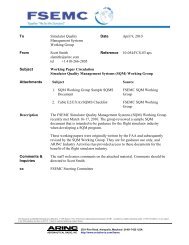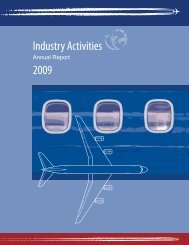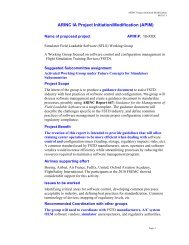(AGIE) Using Internet Protocols - Aviation Committees - AEEC - AMC
(AGIE) Using Internet Protocols - Aviation Committees - AEEC - AMC
(AGIE) Using Internet Protocols - Aviation Committees - AEEC - AMC
- No tags were found...
Create successful ePaper yourself
Turn your PDF publications into a flip-book with our unique Google optimized e-Paper software.
4.0 <strong>AGIE</strong> FUNCTIONAL SPECIFICATIONARINC PROJECT PAPER 830 – Page 31with persistent store should provide status of message segments already receivedand being held to minimize resending of large data.<strong>AGIE</strong> clients shall be designed to support multiple simultaneous applications via amulti-threaded interface. While It is not actually required for implementers on theapplication side to implement the multi-threaded interface, the <strong>AGIE</strong> client shallnonetheless provide such an interface if it is implemented. This allows multiplesimultaneous message transfers and service requests. It also provides built-inapplication name/ID addressing to support application mapping of incomingmessages via meta-data parameter (Application ID). The application ID provides ameta-data tag for use by end system application’s message routing function for easydetermination of the appropriate destination application. <strong>AGIE</strong> does not process theApplication ID other than to parse it, put it in the message, and pass it on to theapplication interface.COMMENTARYWhile it is assumed that the client and application interface is local, it ispossible that a client and its application may be separated by a datalink ormultiple <strong>Internet</strong> links.To avoid messages from being blocked by another higher priority message the<strong>AGIE</strong> client shall provide the following communication capabilities:1. The application-to-client interface operates at a performance level thatallows multiple applications to submit message requests to clients such thatno large, low priority message will block a later arriving small, high priorityone.2. The client-to-application interface operates at a performance level thatallows multiple applications to receive messages from clients such that nolarge, low priority message will block a later arriving small, high priority one.3. The client-to-server interface operates at a performance level that allowsmultiple messages to be sent to hosts such that no large, low prioritymessage will block a later arriving small, high priority one.4. The server-to-client interface operates at a performance level that allowsmultiple messages to be received from hosts such that no large, low prioritymessage will block a later arriving small, high priority one.5. The Application ID is handled by the originating client mapping theApplication ID to a field in message header and destination client passingthe field in XML to application. If the Application ID is “” then the ApplicationID becomes “DEFAULT.”Applications may direct messages to any application by setting the Application IDfield, or may omit it all together. The Application ID is an element in the <strong>AGIE</strong> namedescriptor. It may be used by the end user application routing function as meta-datato allow straight forward selection of the appropriate destination application by endsystem software handler. This allows application-to-application message mappingwhere only the two end applications need to be concerned with the Application IDstring. No <strong>AGIE</strong> internal messaging functionality is required to support thiscapability.Client-host server interface provides for well defined, secure interaction between theclient being hosted, <strong>AGIE</strong> services, and the <strong>AGIE</strong> network and shall always be overIP.










